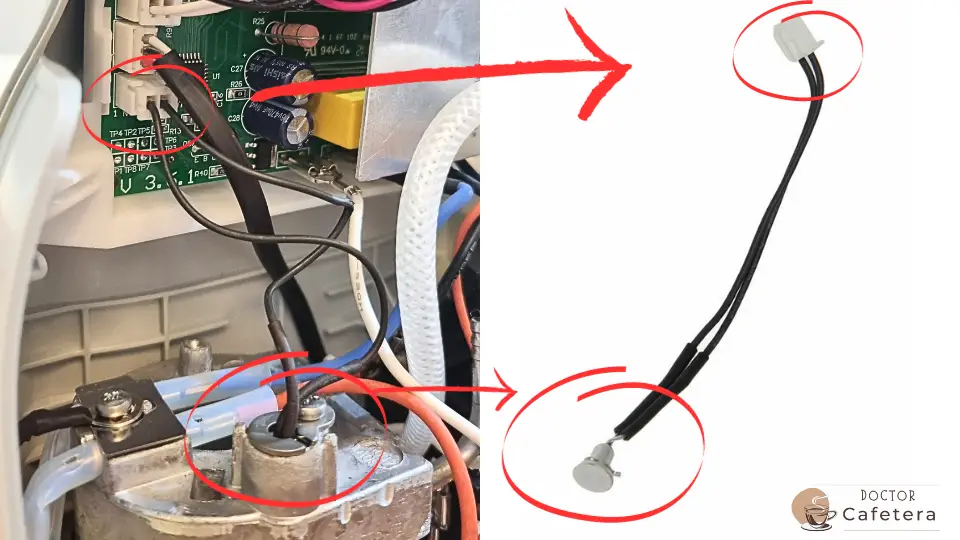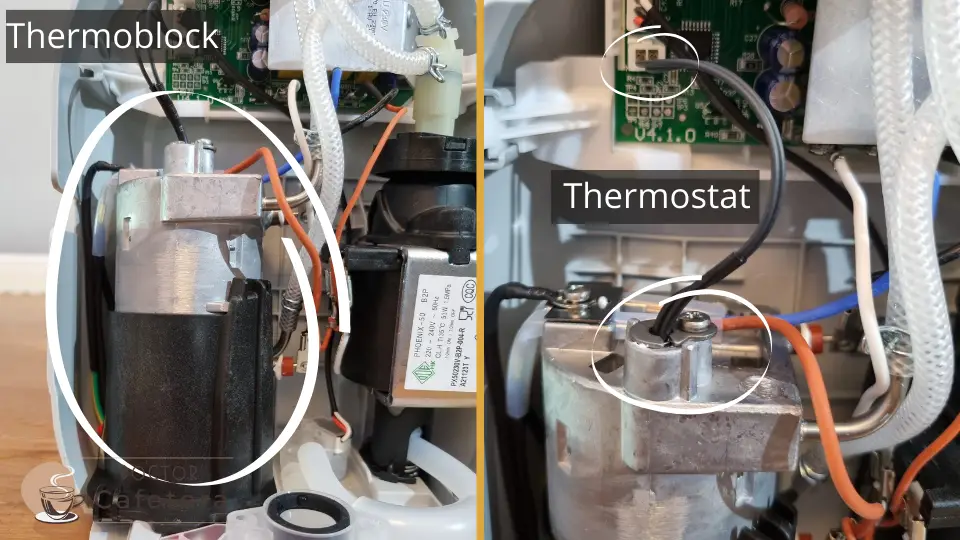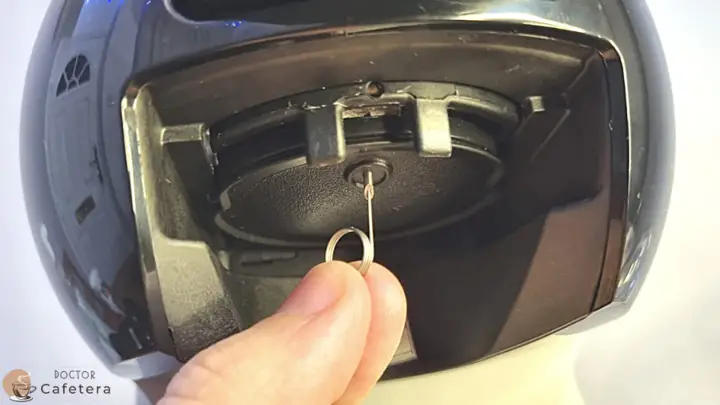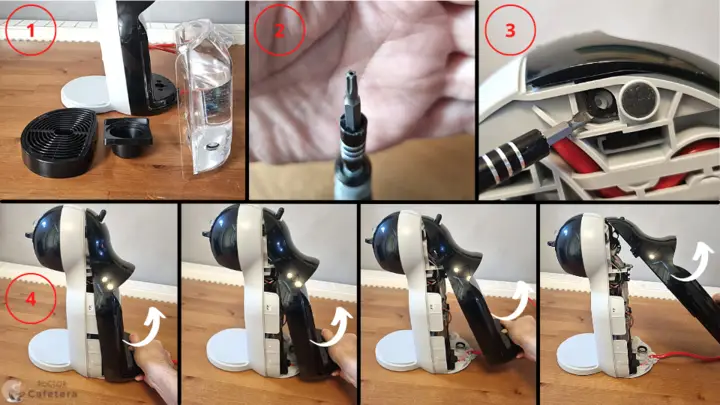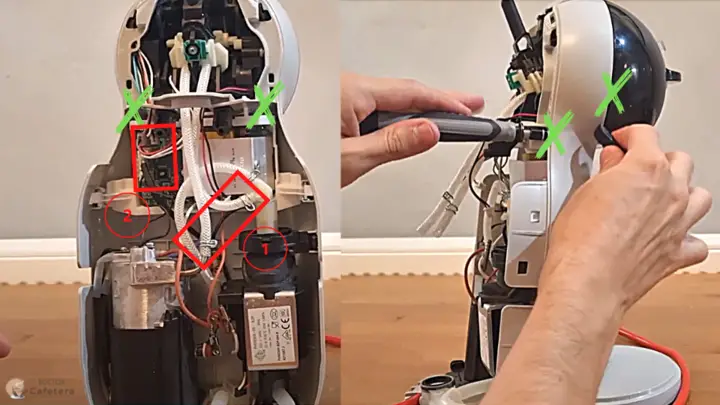Over 20.7 million coffee pod machines have been sold in the United States in the last decade. Given that these machines represent 25% of the global market, it’s estimated that more than 80 million units have been sold worldwide. Among these, Nespresso and Keurig are the leading brands, closely followed by Dolce Gusto coffee machines.
With so many machines in use for an extended period, encountering issues and malfunctions is not uncommon. Check the user manual for guidance if you’re experiencing problems with your Dolce Gusto machine.
Dolce Gusto machine turns off by itself
If the coffee machine shuts off by itself, we face one of the most serious problems a Dolce Gusto coffee machine can experience. This automatic shutdown is a safety measure to protect the appliance itself or the user.
Sometimes, the Dolce Gusto doesn’t allow you to prepare coffee because one of its sensors is not sending a positive signal, for example, if the capsule holder is missing. In this case, the coffee maker doesn’t turn off because there is no danger as long as no coffee is being prepared. So, which sensor sends a shutdown signal to the coffee maker?
It is a faulty thermostat whose default position is “closed circuit.” Therefore, once the Dolce Gusto is turned on, it will always heat the boiler until it reaches a certain temperature; at this point, it switches to an “open circuit” and stops heating.
⚠️ If the thermostat were faulty and the coffee maker remained on, the boiler would continuously heat up until it either exploded due to internal pressure or melted the plastic components around it. This is why the coffee maker shuts off, to protect the appliance and the user.
Solution: Unplug the Dolce Gusto and disassemble its casings, as this article explains. Once you access the boiler and the thermostat, you should disconnect the thermostat from the boiler and check for continuity; remember that it defaults to the “closed circuit” position.
Disconnect the connector from the control board; it’s defective if you don’t get continuity. In that case, you must purchase a replacement and swap out the old one.
The Dolce Gusto won’t turn on
Another serious issue with Dolce Gusto machines, and many other brands, is when the coffee maker doesn’t turn on, not even the power button light. In this case, the coffee maker seems dead; no matter what you do, it remains that way.
In this instance, it’s either that the control board isn’t receiving power, or if it does, the power fades away in the capacitors (if the issue is with the capacitors, you might see a very faint light on the power button when you plug it in).
You should check several electrical circuit points for interruptions to resolve this situation. First, ensure that the plug and power cord are in good condition, and second, check for continuity in the thermal fuses.
If there is continuity and the current reaches the control board without any issues, the capacitors will be defective. In cases with a faulty capacitor, you must replace it (refer to this article to learn how to measure capacitance) or purchase a replacement control board.
The Dolce Gusto does not heat up
The key to getting a good coffee is to pass hot water at high pressure through the ground coffee. What happens if we have the right water pressure but not the temperature? In this case, the coffee will lack body because the water temperature is necessary to extract the aroma from the ground coffee. In reality, this won’t even be infused coffee, and its taste won’t be pleasant.
There are two possibilities regarding the lack of temperature in the water poured by our Dolce Gusto:
Issue 1: If the water has progressively lost temperature over time, it directly points to an excess limescale inside the thermoblock.
Solution 1: To address this problem, descale your Dolce Gusto immediately. Limescale acts as an insulating layer in the thermoblock, preventing it from functioning properly, and the water will end up lukewarm in your cup.
Issue 2: If the Dolce Gusto suddenly starts pouring completely cold water, it’s most likely that the thermostat or the thermoblock itself has malfunctioned.
Solution 2: Check for continuity in the thermostat and the heating element; you will need to replace them if they do not show it.
Dolce Gusto does not pour water
Sometimes, our Dolce Gusto makes a noise one day, but no water comes out when we move the preparation lever. Everything seems to be in order; the plug is in the socket, and the lights are green, but the machine doesn’t prepare our desired morning coffee.
We can first rule out a thermostat failure; as we saw in the previous section, the Dolce Gusto would shut off independently. Although it may seem obvious, have you checked that the water tank is properly placed? Make sure the outlet valve is raised.
Once the obvious is ruled out, you need to delve deeper and inspect other sensors that the coffee maker has, such as the flow meter or the coffee pod holder sensor. Since this topic is a bit complicated, I’ve prepared another article that examines it in depth: Why doesn’t a Dolce Gusto coffee maker pour water?
Water pressure Issues in the Dolce Gusto
If the water pressure doesn’t reach the required bars (19 in Dolce Gusto machines), the coffee obtained will be more like drip coffee. So, if your coffee maker can’t inject hot water inside the coffee pod, you’ll get beverages with less body and more acidity.
The primary cause of malfunctions in any coffee maker model and brand is a lack of cleaning and maintenance. When a coffee maker is not properly maintained, especially regular descaling, it clogs internally. Excessive limescale in the internal pipes, the pump, and especially the thermoblock will result in water not coming out with sufficient pressure.
This descaling process can be done with the products Dolce Gusto recommended and white vinegar, although manufacturers do not recommend it.
After discussing the often-overlooked descaling process, I assume you have already checked that the injector is free of impurities, which is not the issue. Here, I’ll explain how to disassemble it and clean it thoroughly.
Why does the Dolce Gusto leak?
As I’ve mentioned in other issues with Dolce Gusto machines, you should narrow down the location of the problem as much as possible.
We know that if the machine is leaking, it is due to some issue in the water circuit. However, this circuit has many components that could cause the dripping: the water reservoir, rubber gaskets, valves, internal pipes, the pump, the thermoblock, or the injector.
In this video, I show you how to disassemble it and identify all its components:
Once we have listed the possible elements, let’s differentiate between two different areas of leaking:
- On the one hand, the bottom of the machine is where any of the internal components we have seen may be causing this unwanted water leakage.
- On the other hand, the top of the coffee maker is where the culprit will be the injector or the coffee pod holder. In this other video, you can see how to disassemble it and clean it:
Why does the Dolce Gusto vibrate and make so much noise?
Dolce Gusto machines typically have a noticeable vibration but fall within the normal range. Excessive vibration in these coffee makers is not very common; however, there can be various reasons why the pump starts vibrating excessively. The main causes include:
- A loose moving part inside or outside.
- Placing the coffee maker on an unstable surface amplifies the normal pump vibration.
- Loose or damaged rubber dampers in the pump.
- Defective control board.
👉 Make sure your Dolce Gusto is indeed noisy; here I show you the sound produced by a Dolce Gusto Mini Me (Measured with a mobile application at a few centimeters from the coffee maker):
Why does the Dolce Gusto make so much noise?
Firstly, we need to determine whether the noise our Dolce Gusto makes is something new or has always been the same. This is important because if the noise suddenly increases, we may be dealing with a malfunction.
Let’s assume that the noise has suddenly increased. In this case, you should ensure that the excess noise is not due to excessive vibration of the coffee maker since, if it were, it would lead to the situation described earlier. Excessive vibration can also occur when the pump or another internal component “comes loose” and vibrates.
For this section on the vibration and sound of the Dolce Gusto, I have created an exclusive and in-depth article that I hope will clarify all your doubts.
How to remove a stuck coffee pod in a Dolce Gusto
If you want to prevent your coffee pods from getting stuck in the coffee maker, you should first change your habits. I know it can be challenging, even though it’s a simple gesture, as I also leave the pods inside the Dolce Gusto until the next preparation.
Cause: These pods get stuck because, after brewing, the ground coffee continues to release gases, which combine with the water that remains inside the pod and cause it to swell.
Solution: Let more water flow through the pod before opening it, as you need the coffee to soften and loosen with moisture and temperature. Then try to open the lid, and if you can’t, repeat the process, but never force the head, as damaging it would require a new coffee maker.
How do you disassemble a Dolce Gusto?
In many previous malfunctions and issues, we’ve mentioned that you should disassemble your Dolce Gusto. However, in none of the cases have we explained how to do it. It’s time to learn how to disassemble a Dolce Gusto:
- We first need to disassemble all the movable parts: the water reservoir, coffee pod holder, and drip tray.
- The second step is to use a Torx-10 security screwdriver and remove the screws located on the back of the machine. There will be 4 to 8 screws, depending on the model.
- Thirdly, you should look for the securing tabs on the bottom of the machine and release them gently (without breaking them).
- Finally, lift the casing by making a bottom-to-top twisting motion, as shown in the image below.
Your specific model may vary slightly from the Dolce Gusto Mini Me coffee maker in the example; however, all Dolce Gusto models follow the same pattern described above.
How to disassemble the head of a Dolce Gusto coffee maker
Taking apart the head of the Dolce Gusto coffee maker is relatively straightforward. To carry out this process, I’ve created a step-by-step list of instructions, along with an image and a video to assist you with the task:
- Disconnect the two plastic tubes that connect the head to the pump and the thermoblock.
- Disconnect all the cables that connect the head to the thermoblock.
- Insert a flathead screwdriver into the holes marked with an ‘X’ to release a plastic tab. There is one tab on each side of the coffee maker. Be careful not to break them.
- At the same time, insert a plastic tool between the head casing and the machine chassis.
- Repeat the process on the other side of the coffee maker.
- Pull the head forward with small lateral movements until it is completely removed.
Useful information on Dolce Gusto machine breakdowns
I have said it many times in this blog, but I will repeat it here: if you purchased your Dolce Gusto less than 30 days ago, you should contact the seller to proceed with the machine’s return.
If your coffee machine is more than 30 days old and you keep the purchase receipt, you can return it under the terms of the warranty (in most cases, 2 years). In the United States, the warranty is handled by Nestlé professional, and in the rest of the world, by Dolce Gusto.
Dolce Gusto UK
Dolce Gusto AUS
Dolce Gusto US
- US Contact form
- Service 800-745-3391
- 800-288-8682
